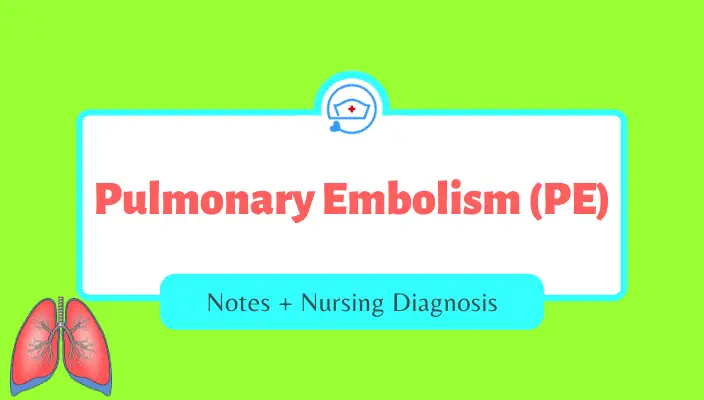Last updated on December 28th, 2023
Here, we’ll briefly about Pulmonary Embolism (PE) and nursing diagnoses for PE.
What is Pulmonary Embolism (PE)?
Pulmonary embolism refers to the obstruction of the pulmonary artery or one of its branches. This occlusion occurs due to a particulate matter (solids, liquids, or air) that originates or invades into the venous circulation and then travels up to occlude pulmonary vessels.
Most common cause of pulmonary emblosim is blood clots formed as a result of DVT (deep vein thrombosis). Both the pulmonary embolism (PE) and DVT (deep vein thrombosis) are so common that it affects every 1 to 2 in 1000 people in America. Also, Pulmonary Embolism and DVT are responsible for approximately 100,000 per year in the United States alone.
Risk Factors
Risk factors associated with pulmonary embolism include:
- Injuries like bone fracture, muscle tears can cause damage to blood vessels, leading to clots.
- Inactivity: During prolonged immobility, gravity causes blood to remain stagnant in the lowest part of the body, which may form a blood clot.
- Smoking
- Cancer
- Recent surgery
- Pregnancy
- Obesity with BMI > 30
- Age greater than 40
Clinical Features
Signs and symptoms of pulmonary embolism include:
- Apprehension and restlessness
- Blood tinged sputum
- Chest pain
- Cough
- Crackles and wheezes on auscultation
- Distended neck vein
- Dyspnea
- Petechiae over the chest and axilla
- Hypotension
Diagnostic Testing
- Chest X ray
- Electrocardiography
- Magnetic resonance imaging (MRI)
- V/Q scan ( ventilation/ perfusion scan )
- Pulmonary angiography
- Venography
- D dimer test
Medical and Surgical Management
- Administration of anticoagulants like heparin, warfarin to prevent new clots from forming in the blood.
- Thrombolytics are used to dissolve the clots.
- Surgeries are performed to remove problematic clots or to place vein filter to trap the clots.
Pulmonary Embolism Nursing Diagnosis
Actual Pulmonary Embolism Nursing Diagnoses
1. Ineffective breathing pattern related to increase in alveolar dead space, physiologic lung changes due to embolism, bleeding, increased secretions, decreased lung expansion, inflammation as evidence by dyspnea, use of accessory muscles, shallow respirations, tachypnea, increased work of breathing, decreased chest expansion on involved side, cough with or without productivity, adventitious breath sounds
2. Impaired gas exchange related to atelectasis, airway obstruction, alveolar collapse, pulmonary edema, increased secretions, active bleeding, altered blood flow to lung, shunting as evidence by dyspnea, restlessness, anxiety, apprehension, cyanosis, arterial blood gas changes, hypoxemia, hypoxia, hypercapnia, decreased oxygen saturation
3. Acute pain related to lack of oxygen to cells, trauma as evidence by verbal report of pain, facial grimacing, restlessness, changes in pulse, blood pressure
4. Fear/Anxiety related to severe dyspnea, inability to breathe normally, perceived threat of death, change in health status, physiological response to hypoxemia and acidosis, as evidence by restlessness, irritability, withdrawal or attack behavior, apprehension, sympathetic stimulation (cardiovascular excitation, pupil dilation, sweating, vomiting, diarrhea), crying, voice quivering, an impending sense of doom
5. Deficient Knowledge related to activities to prevent embolism, self-care after diagnosis of embolism as evidence by request for information, statement of misconception, statement of concerns
Risk Nursing Diagnoses for Pulmonary Embolism (PE)
1. Risk for decreased cardiac output: risk factors may include dysrhythmias, cardiogenic shock, heart failure
2. Risk for ineffective cerebral/ renal/ cardiac tissue perfusion: risk factors may include cardiogenic shock, heart failure, pulmonary artery occlusion
Reference
Comer, S. and Sagel, B. (1998). CRITICAL CARE NURSING CARE PLANS. Skidmore-Roth Publications.
Gulanick, M. and Myers, J. (2014). NURSING CARE PLANS: Diagnoses, Interventions, and Outcomes (8th ed.). Elsevier/Mosby.
Herdman, T., Kamitsuru, S. & Lopes, C. (2021). NURSING DIAGNOSES: Definitions and Classifications 2021-2023 (12th ed.). Thieme.
Swearingen, P. (2016). ALL-IN-ONE CARE PLANNING RESOURCE (4th ed.). Elsevier/Mosby.


